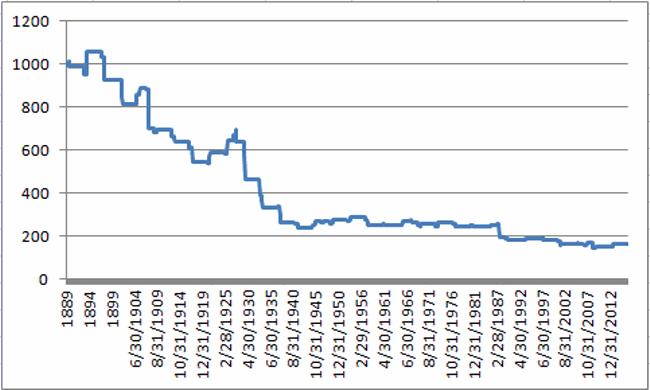We are going to go “off the beaten” a bit (or perhaps I should say a bit more than usual) this time out and highlight an anomaly that may be either:
*Potentially very useful
*Completely Random
You make the call.
(See also A Two-Fund Portfolio for the Next 3 Months)
A Tale of Two “Types of Years” and 3 Unfavorable Months Therein
In the realm of the slightly mind-addled world of seasonal trend analysis, 2017 is:
*A Post-Election Year
*Year “7” in the Decennial Calendar
For what follows we will use monthly closing prices for the Dow Jones Industrials Average starting in 1889 (yes, I said 1889).
For reasons I cannot explain the months of February, September and October are the only months that have lost money on the whole during both Post-Election years and during Years ending in “7” (1897, 1907, etc.).
Figure 1 displays the growth of $1,000 invested during the months of February, September and October during Post-Election years starting with 1889. Figure 1 – Growth of $1,000 invested in Dow Industrials during February, September and October of Post-Election Years only starting in 1889
Figure 1 – Growth of $1,000 invested in Dow Industrials during February, September and October of Post-Election Years only starting in 1889
Figure 2 displays the growth of $1,000 invested during the months of February, September and October during Years ending in “7” starting with 1897. Figure 2 – Growth of $1,000 invested in Dow Industrials during February, September and October of Years ending in “7” only starting in 1897
Figure 2 – Growth of $1,000 invested in Dow Industrials during February, September and October of Years ending in “7” only starting in 1897
As you can see in Figures 1 and 2, for some inexplicable reason during these 3 months during these 2 “types” of years, the Dow just doesn’t seem to ever do much to the upside.
Now let’s put these Years and Months together. For the next test we will assume that:
*We buy and hold the Dow Jones Industrials Average ONLY during the months of February, September and October
*ONLY during Post-Election years and in Years ending in 7.
*We start with $1,000 on 12/31/1888
Figure 3 displays the results. Figure 3 – Growth of $1,000 invested in Dow Jones Industrial Average only during months of February, September and October during Post-Election years and Years ending in “7”
Figure 3 – Growth of $1,000 invested in Dow Jones Industrial Average only during months of February, September and October during Post-Election years and Years ending in “7”
The net result – a cumulative loss of -84%.
For the record:
*# of times these 3 months showed a cumulative gain = 15 (39%)
*# of times these 3 months showed a cumulative loss = 23 (61%)
*Average gain during positive years = +5.2%
*Average loss during negative years = (-10.2%)
While the chart in Figure 3 suggests a steady long-term decline during these unfavorable months, the reality is that these 3 months only register a net loss in 3 out of every 5 Post-Election years or Years ending in 7.
Summary
The results above fit neatly into the “Well it’s interesting and sort of seems important, but what exactly am I supposed to do with this knowledge?” category.
So what is in investor to do? Move to cash during February, September and October this year? Well that’s one approach. Overkill? Perhaps. Another approach might be to consider hedging if the market begins to roll over, particularly during the often troublesome months of September and October.
The concerns for September and October do dovetail with the cautionary tale told in this previous article.
Jay Kaeppel


I can get my head around post election years and the challenge with trading Sept & Oct but years ending in 7 … not so much.
Keep it coming!
Ryan, if you go to the following link (http://www.pring.com/pdfs/cyclicoutlook.pdf)- a work by Martin Pring – and scroll down to Page 2 you will see the “typical” Decennial Pattern. Year “7” has a history of suffering a significant pullback somewhere along the way. Obviously this varies from decade to decade, but basically that is where the whole “Year 7” thing comes from. Jay